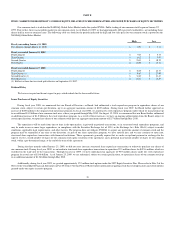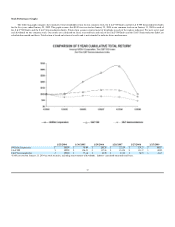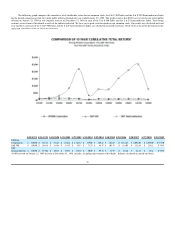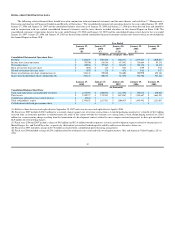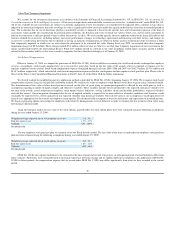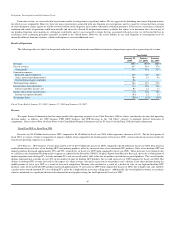NVIDIA 2008 Annual Report Download - page 44
Download and view the complete annual report
Please find page 44 of the 2008 NVIDIA annual report below. You can navigate through the pages in the report by either clicking on the pages listed below, or by using the keyword search tool below to find specific information within the annual report.
Our share of the standalone desktop GPU category decreased from 64% to 63% in fiscal year 2009, according to the December 2007 and December 2008 PC
Graphics Report from Mercury Research, respectively. Our share of the standalone notebook category decreased from 75% to 63%, according to the December
2007 and December 2008 PC Graphics Report from Mercury Research, respectively, due to increased competition in the marketplace. During fiscal year 2009, our
revenue from Desktop GPU products declined approximately 29% compared to fiscal year 2008. This decline was driven primarily as a result of a decline of over
20% in the number of units of Desktop GPU products that we sold, while average selling prices of our Desktop GPU products were flat to slightly lower in fiscal
year 2009 when compared to fiscal year 2008. We believe that some portion of the decline in our Desktop GPU unit sales reflects a shift in consumer preference
towards notebook PCs and away from desktop PCs, and that the overall global economic recessionary climate also contributed to the decline. As such, we noted
that unit sales of our Notebook GPU products increased over 10% during fiscal year 2009 when compared to fiscal year 2008. However, the overall global economic
recessionary climate contributed to a significant decline in the demand for total graphics during the fourth quarter of fiscal year 2009. If consumer preferences
towards notebook PCs, and away from desktop PCs, continue or escalate, we may see further declines in sales of our Desktop GPU products. In addition, if the
global economic climate does not recover during fiscal year 2010, or deteriorates further, we may see consumer preferences move towards lower
-
priced notebook
PCs, which may negatively impact sales of our Notebook PC products.
Professional Solutions Business
Our PSB is comprised of our Quadro professional workstation products and other professional graphics products, including our NVIDIA Tesla high
-
performance computing products. During fiscal year 2009, we launched several new Quadro solutions, including the Quadro FX 3600M Professional, and the
Quadro Plex D Series, a dedicated desk side Visual Computing System, or VCS, system that also can be configured (using two Quadro Plex D systems) for a 3U
configuration. We also launched five new Quadro FX notebook GPUs that spanned from ultra
-
high performance to ultra mobility, as well as the Quadro CX
accelerator for Adobe
’
s Creative Suite 4, or Adobe CS4, content creation software.
During fiscal year 2009, we also launched the Tesla C1060 computing processor and the Tesla S1070 computing system. Tesla is a new family of GPU
computing products that delivers processing capabilities for high
-
performance computing applications, and marks our entry into the high
-
performance computing
industry. The Tesla family also consists of the C870 GPU computing processor, the D870 Deskside Supercomputer and the S870 1U Computing Server. We believe
we are in an era of GPU computing, where our Compute Unified Device Architecture, or CUDA, parallel processing architecture can accelerate compute
-
intensive
applications by significant multiples over that of a CPU alone. NVIDIA CUDA is a general purpose parallel computing architecture that leverages the parallel
compute engine in our graphics processing units to solve many complex computational problems in a fraction of the time required on a CPU. In order to program
using the CUDA architecture, developers can, today, use C, one of the most widely used high
-
level programming languages, which can then be run at great
performance on a CUDA enabled processor. We expect other languages to be supported in the future, including FORTRAN and C++. With CUDA, we are able to
speed up general purpose compute
-
intensive applications like we do for 3D graphics processing. Developers are able to speed
-
up algorithms in areas ranging
from nano molecular dynamics to image processing, medical image reconstruction and derivatives modeling for financial risk analysis. Many PC OEMs now offer
high performance computing solutions with Tesla for use by customers around the world. Researchers use CUDA to accelerate their time
-
to
-
discovery, and
popular off
-
the
-
shelf software packages are now CUDA accelerated.
We have achieved a leading position in the professional graphics category by providing innovative GPU technology, software, and tools that integrate the
capabilities of our GPU with a broad array of visualization products.
MCP Business
Our MCP business is comprised of NVIDIA nForce core logic and NVIDIA GeForce mGPU products. Our NVIDIA nForce and GeForce mGPU families of
products address the core logic market. During fiscal year 2008, we announced a new technology named Hybrid SLI, which combines a powerful yet energy
-
efficient engine with our multi
-
GPU SLI technology. During fiscal year 2009, we shipped Hybrid SLI DirectX 10, or DX10, mGPUs –
the GeForce 8000 GPU
series. We also extended the reach of SLI technology into the performance category with the launch of our overclockable NVIDIA nForce 790i Ultra SLI MCP for
Intel processors.
We also launched SLI for Intel Broomfield CPU platforms.
In fiscal year 2009, we also launched the GeForce 9400M mGPU along with Apple, Inc., or Apple, for their new lineup of Mac notebooks. The GeForce
9400M integrates three complex chips – the northbridge, the input
-
output network processor, and the GeForce GPU into a single chip and, as a result, significantly
improves performance over Intel integrated graphics. Apple
’
s MacBook and MacBook Air notebook computers come standard with the GeForce 9400M. Apple
’
s
MacBook Pro notebook computer comes standard with the hybrid combination of two GeForce GPUs
-
a GeForce 9400M for maximum battery life and a GeForce
9600M GT for high performance mode. We also launched the GeForce 9400 and 9300 mGPUs for Intel desktop PCs. These new mGPUs set a new
price/performance standard for integrated graphics by combining the power of three different chips into one highly compact and efficient GPU.
Additionally, in fiscal year 2009, we announced the NVIDIA Ion Platform, which combines the GeForce 9400 GPU with the Intel Atom CPU. The combination
enables netbooks, small form factor and all
-
in
-
one PCs to play rich media and popular games in high definition.
41







